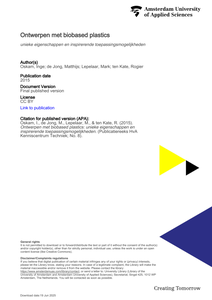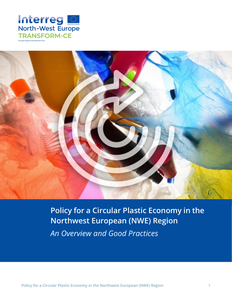‘Ontwerpen met biobased plastics’ is de eindpublicatie van het project “Design Challenges with Biobased Plastics”. In dit onderzoeksproject deed de HvA, samen met diverse mkb-bedrijven onderzoek naar de kennis een tools die ontwerpers nodig hebben om biobased plastics, kunststoffen van hernieuwbare materialen, toe te passen. De publicatie gaat in op de kansen die biobased plastics bieden en biedt praktische tools, inspirerende voorbeelden en handreikingen die het ontwerpen met deze materialen makkelijker maken.
DOCUMENT

DOCUMENT

Polyhydroxyalkanoates (PHAs) form a highly promising class of bioplastics for the transition from fossil fuel-based plastics to bio-renewable and biodegradable plastics. Mixed microbial consortia (MMC) are known to be able to produce PHAs from organic waste streams. Knowledge of key-microbes and their characteristics in PHA-producing consortia is necessary for further process optimization and direction towards synthesis of specific types of PHAs. In this study, a PHA-producing mixed microbial consortium (MMC) from an industrial pilot plant was characterized and further enriched on acetate in a laboratory-scale selector with a working volume of 5 L. 16S-rDNA microbiological population analysis of both the industrial pilot plant and the 5 L selector revealed that the most dominant species within the population is Thauera aminoaromatica MZ1T, a Gram-negative beta-proteobacterium belonging to the order of the Rhodocyclales. The relative abundance of this Thauera species increased from 24 to 40% after two months of enrichment in the selector-system, indicating a competitive advantage, possibly due to the storage of a reserve material such as PHA. First experiments with T. aminoaromatica MZ1T showed multiple intracellular granules when grown in pure culture on a growth medium with a C:N ratio of 10:1 and acetate as a carbon source. Nuclear magnetic resonance (NMR) analyses upon extraction of PHA from the pure culture confirmed polyhydroxybutyrate production by T. aminoaromatica MZ1T.
LINK
For the future circular economy, renewable carbon feedstocks manifest considerable promise for synthesizing sustainable and biodegradable polyhydroxyalkanoate (PHA). In this study, 16 wt% and 30 wt% PHA (cell dry weight) are respectively produced by thermophilic Caldimonas thermodepolymerans from beechwood xylan and wheat arabinoxylan as the sole carbon source. Moreover, an in silico study of the potential xylan-degrading proteins was conducted using proteome sequencing and CAZyme specialized bioinformatic tools. This study demonstrates the feasibility of utilizing complex polysaccharide substrates for PHA biosynthesis, thereby potentially eliminate additional processing steps and reducing overall production costs for sustainable plastic.
MULTIFILE

Worldwide, plastic cups are used for serving drinks. Some typical examples of large-scale consumption are large concerts and festivals. As a part of the BIOCAS project, which focusses on the valorization of biomass through various routes, a PHA biobased festival cup was developed and created to reduce the impact of current fossil plastics. The role of VHL was to assess the environmental impact. The aim of the report is to inform the BIOCAS-partners about the use of plastic cups, and address the environmental impact in comparison with other types of biobased plastic cups and fossil-based cups. This report can serve as a basis for making choices within all different types of (plastic/biobased) cups. Besides, it can be used as a public communication tool about the environmental impact of different types of (plastic/biobased) cup applications.
DOCUMENT

Overusing non-degradable plastics causes a series of environmental issues, inferring a switch to biodegradable plastics. Polyhydroxyalkanoates (PHAs) are promising biodegradable plastics that can be produced by many microbes using various substrates from waste feedstock. However, the cost of PHAs production is higher compared to fossil-based plastics, impeding further industrial production and applications. To provide a guideline for reducing costs, the potential cheap waste feedstock for PHAs production have been summarized in this work. Besides, to increase the competitiveness of PHAs in the mainstream plastics economy, the influencing parameters of PHAs production have been discussed. The PHAs degradation has been reviewed related to the type of bacteria, their metabolic pathways/enzymes, and environmental conditions. Finally, the applications of PHAs in different fields have been presented and discussed to induce comprehension on the practical potentials of PHAs.
DOCUMENT
Polymeren, waaronder plastics, kennen we allemaal uit ons dagelijks leven. Van de plastic draagtas tot computeronderdelen en kopjes. Allemaal worden deze polymeren vervaardigd uit aardolie en afgeleide producten. De producten zijn zeer nuttig en breed toepasbaar, mede door de gunstige eigenschappen zoals warmteweerbaarheid, stevigheid en waterdichtheid. Daarentegen kennen polymeren ook een keerzijde, zoals het niet of moeilijk afbreekbaar zijn in de natuurlijke omgeving en de nadelen van het gebruik van fossiele bronnen: hun eindigheid en de ongecontroleerde emissie van broeikasgassen die verband houdt met klimaatverandering. Dit is een zichtbaar probleem bij onder meer De Plasticsoep, waar geen of beperkte afbraak plaatsvindt van plastics in de oceaan. De zoektocht naar alternatieven is daarom volop aan de gang.
DOCUMENT

This document combines four reports on existing regional business support programmes for inclusion or understanding of circular economy (CE) objectives, deliverable DT3.1.2 from the transform-CE project. Besides a general overview on national and regional level, the focus is on a selection of national and regional programmes aimed at the plastics industry. After explaining the format to structure the programmes, the results for the four regions are presented: Greater Manchester (UK), Rhineland Palatinate and North-Rhine Westphalia (DE), Wallonia (BE), Central Netherlands (NL).
MULTIFILE

Het boek ‘3D Printing with biomaterials’ introduceert een manier om een duurzame en circulaire economie te realiseren; 3D printen gecombineerd met het gebruik van biomaterialen.
DOCUMENT
